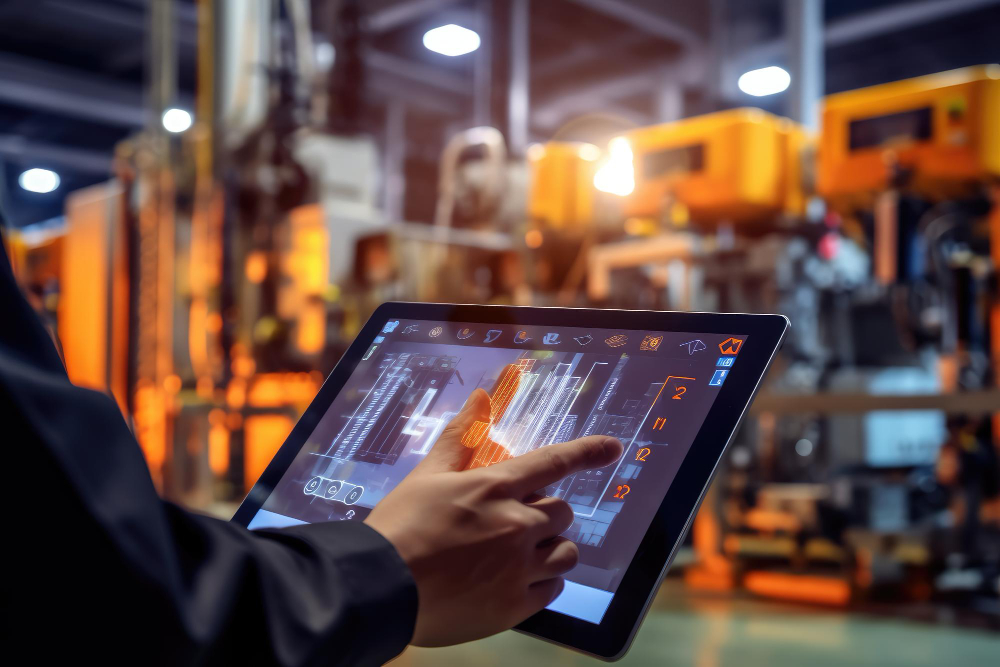IoT technologies are increasingly common in the management of an industrial building. In short, IoT means the interconnection of devices, from smartphones and laptops to thermostats, and networks through sensors. When connected, such devices send, collect and analyze data, making information of interest accessible in real time. The data is sent to a cloud platform (a SaaS tool) where it is analyzed and returns useful information that enables predictive and proactive maintenance of all assets in various industries.
How IoT is used in predictive maintenance
Numerous IoT sensors are “put to work” in the predictive maintenance process. These sensors help detect, collect and store important data for tracking and monitoring machinery and assets throughout the facility. Let’s see how it works.
Implementation of sensors
IoT technology needs sensors to collect the right data in order to function. Therefore, installing the sensors is a necessary step, although relatively not very complicated, so that the software can properly collect the data from the equipment.
Data collection and analysis
The deployed sensors then begin to collect data about the equipment’s behavior. Collected data is sent to a centralized cloud server for data analysis. What the sensors search for can vary depending on the equipment they are installed on and how they have been programmed. They can measure equipment performance, temperature, vibration and other relevant values.
After the collected data reaches the cloud server, it is stored and used to train machine learning algorithms. This will help the predictive maintenance platform work more efficiently.
Alerts and notifications
The biggest advantage of real-time monitoring is that IoT predictive maintenance systems will promptly notify you of any issues that arise. Not all equipment will always need repair. Therefore, it is important for the equipment maintainer to check the alerts.
Integration with CMMS
Repair history can be integrated into CMMS. All the data collected over time can help you gain useful information about signs of equipment failure so you can plan preventive maintenance. For example, if the platform suggests that a high temperature is related to a particular equipment failure, you can take action to keep that asset cooler.
You can also track sensor data in real-time to monitor the current status of all equipment. This allows you to speed up your reaction time to prevent safety issues and reduce downtime. It’s also a way to proactively monitor critical assets that could lead to workflow disruptions if issues aren’t addressed.
Artificial intelligence and machine learning
Predictive models need historical data to assess the probability of future equipment failures. The IoT predictive maintenance solution uses artificial intelligence (AI) and machine learning (ML) to achieve this.
After sensors are installed on equipment and asset data is collected on a centralized cloud platform, ML algorithms are trained to detect patterns that typically occur before assets are shut down. The system then uses these models as a reference to predict future outcomes based on new real-time data as it emerges. For example, if it observes the same combination of vibration and temperature that precedes when other industrial equipment breaks down, it could predict that the equipment showing these signs is about to malfunction.
The benefits of predictive maintenance for business
- Cost reduction by eliminating downtime: by early identification of possible equipment failures, it is possible to schedule preventive maintenance and avoid downtime, reducing operational costs and increasing process efficiency.
- Longer equipment life: With predictive maintenance, managers can more accurately schedule overhaul work, reducing equipment downtime and increasing asset availability.
- Improved team performance: If you have more working equipment and less downtime, then employees can work more safely and efficiently, increasing company productivity.
The cost of a predictive maintenance system is often high, but preventive maintenance and run-to-failure strategies are not always as cost-effective in the long run. Predictive maintenance is an investment that pays for itself over time. Using this solution not only allows companies to reduce expenses, but also increases revenue with predictive analytics by extending equipment uptime.
Integrating predictive maintenance solutions can be crucial to staying competitive and even outperforming the competition. Learn more about the QLEAP KMR platform developed for equipment performance.



